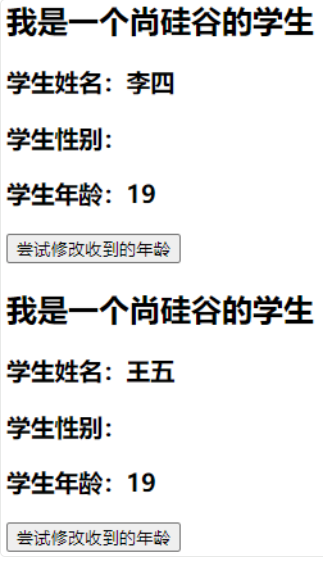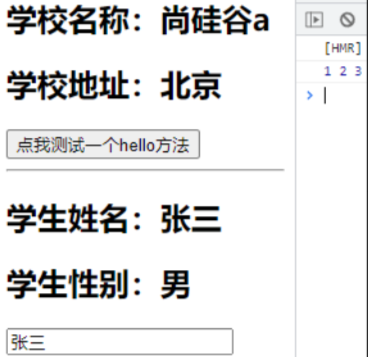1 ref属性
ref 被用来给元素或子组件注册引用信息(id的替代者)- 应用在
html 标签上获取的是真实DOM元素,应用在组件标签上是组件实例对象vc
- 使用方式:
- 打标识:
<h1 ref="xxx">.....</h1> 或 <School ref="xxx"></School>
- 获取:
this.$refs.xxx
1
2
3
4
5
6
7
8
9
10
11
12
13
14
15
16
17
18
19
20
21
22
23
24
25
26
27
28
| <template>
<div>
<h1 v-text="msg" ref="title"></h1>
<button ref="btn" @click="showDOM">点我输出上方的DOM元素</button>
<School ref="sch"/>
</div>
</template>
<script>
import School from './components/School'
export default {
name:'App',
components:{ School },
data() {
return {
msg:'欢迎学习Vue!'
}
},
methods: {
showDOM(){
console.log(this.$refs.title)
console.log(this.$refs.btn)
console.log(this.$refs.sch)
}
},
}
</script>
|

2 props 配置项
功能:让组件接收外部传过来的数据
传递数据:<Demo name="xxx" :age="18"/> 这里age前加:,通过v-bind使得里面的18是数字
接收数据:
- 第一种方式(只接收):
props:['name']
- 第二种方式(限制类型):
props:{name:String, age:Number}
- 第三种方式(限制类型、限制必要性、指定默认值)
1
2
3
4
5
6
7
| props:{
name:{
type:String, //类型
required:true, //必要性
default:'老王' //默认值
}
}
|
备注:props是只读的,Vue底层会监测你对props的修改,如果进行了修改,就会发出警告,若业务需求确实需要修改,那么请复制props的内容到data中一份,然后去修改data中的数据。
vue props 传 Array/Object 类型值,子组件报错解决办法
 其实看错误信息也就知道了,就是Props在传值类型为Object/Array时,**如果需要配置
其实看错误信息也就知道了,就是Props在传值类型为Object/Array时,**如果需要配置default值(如果没有配置default值,则不会有这个报错)**,那必须要使用函数来return这个default值,而不能像基本数据类型那样直接写default:xxx
1
2
3
4
5
6
7
| //错误写法
props: {
rlist: {
type:Array,
default: [1, 2, 3, 4, 5]
}
}
|
解决方法
1
2
3
4
5
6
7
8
9
10
11
12
13
14
15
16
| //正确写法
props: {
rlist: {
type:Array,
default: function() {
return [1, 2, 3, 4, 5]
}
}
}
//当然,我们可以使用箭头函数来写,还显得简单很多
props: {
rlist: {
type:Array,
default: () => [1, 2, 3, 4, 5]
}
}
|
示例代码: 父组件给子组件传数据
App.vue
1
2
3
4
5
6
7
8
9
10
11
12
13
14
15
| <template>
<div>
<Student name="李四" sex="女" :age="18"/>
<Student name="王五" sex="男" :age="18"/>
</div>
</template>
<script>
import Student from './components/Student'
export default {
name:'App',
components:{ Student }
}
</script>
|
School.vue
1
2
3
4
5
6
7
8
9
10
11
12
13
14
15
16
17
18
19
20
21
22
23
24
25
26
27
28
29
30
31
32
33
34
35
36
37
38
39
40
41
42
43
44
45
46
47
48
| <template>
<div>
<h1>{{ msg }}</h1>
<h2>学生姓名:{{ name }}</h2>
<h2>学生性别:{{ sex }}</h2>
<h2>学生年龄:{{ myAge + 1 }}</h2>
<button @click="updateAge">尝试修改收到的年龄</button>
</div>
</template>
<script>
export default {
name: "Student",
data() {
console.log(this);
return {
msg: "我是一个bilibili大学的学生",
myAge: this.age,
};
},
methods: { updateAge() { this.myAge++; }, },
// 简单声明接收
// props:['name','age','sex']
// 接收的同时对数据进行类型限制
// props: {
// name: String,
// age: Number,
// sex: String,
// }
// 接收的同时对数据:进行类型限制+默认值的指定+必要性的限制
props: {
name: {
type: String, //name的类型是字符串
required: true, //name是必要的
},
age: {
type: Number,
default: 99, //默认值
},
sex: {
type: String,
required: true,
},
},
};
</script>
|

3 mixin 混入
混入 (mixin) 提供了一种非常灵活的方式,来分发 Vue 组件中的可复用功能。一个混入对象可以包含任意组件选项。当组件使用混入对象时,所有混入对象的选项将被“混合”进入该组件本身的选项。
功能:可以把多个组件共用的配置提取成一个混入对象
例子:
1
2
3
4
5
| const mixin = {
data() {....},
methods: {....}
....
}
|
使用混入
- 全局混入
Vue.mixin(xxx)
- 局部混入
mixins:['xxx']
局部混入
src/mixin.js
1
2
3
4
5
6
7
8
9
10
11
12
13
14
15
16
17
18
19
| export const hunhe = {
methods: {
showName(){
alert(this.name)
}
},
mounted() {
console.log('你好啊!')
},
}
export const hunhe2 = {
data() {
return {
x:100,
y:200
}
},
}
|
src/components/School.vue
1
2
3
4
5
6
7
8
9
10
11
12
13
14
15
16
17
18
19
20
21
22
23
| <template>
<div>
<h2 @click="showName">学校名称:{{name}}</h2>
<h2>学校地址:{{address}}</h2>
</div>
</template>
<script>
//引入一个hunhe
import {hunhe,hunhe2} from '../mixin'
export default {
name:'School',
data() {
return {
name:'尚硅谷',
address:'北京',
x:666
}
},
mixins:[hunhe,hunhe2] // 局部混入
}
</script>
|
src/components/Student.vue
1
2
3
4
5
6
7
8
9
10
11
12
13
14
15
16
17
18
19
20
21
| <template>
<div>
<h2 @click="showName">学生姓名:{{name}}</h2>
<h2>学生性别:{{sex}}</h2>
</div>
</template>
<script>
import {hunhe,hunhe2} from '../mixin'
export default {
name:'Student',
data() {
return {
name:'张三',
sex:'男'
}
},
mixins:[hunhe,hunhe2] // 局部混入
}
</script>
|
全局混入
src/main.js
1
2
3
4
5
6
7
8
9
10
11
12
| import Vue from 'vue'
import App from './App.vue'
import {mixin} from './mixin'
Vue.config.productionTip = false
Vue.mixin(hunhe)
Vue.mixin(hunhe2)
new Vue({
el:"#app",
render: h => h(App)
})
|
这样所有组件就自动使用这些配置了,不推荐使用全局混入
备注
- 组件和混入对象含有同名选项时,这些选项将以恰当的方式进行“合并”,在发生冲突时以组件优先
1
2
3
4
5
6
7
8
9
10
11
12
13
14
15
16
17
18
19
20
21
22
| var mixin = {
data: function () {
return {
message: 'hello',
foo: 'abc'
}
}
}
new Vue({
mixins: [mixin],
data () {
return {
message: 'goodbye',
bar: 'def'
}
},
created () {
console.log(this.$data)
}
})
|
- 同名生命周期钩子将合并为一个数组,因此都将被调用。另外,混入对象的钩子将在组件自身钩子之前调用
1
2
3
4
5
6
7
8
9
10
11
12
13
14
15
| var mixin = {
created () {
console.log('混入对象的钩子被调用')
}
}
new Vue({
mixins: [mixin],
created () {
console.log('组件钩子被调用')
}
})
|
4 plugin 插件
- 功能:用于增强 Vue
- 本质:包含 install 方法的一个对象,install 的第一个参数是Vue构造函数,第二个以后的参数是插件使用者传递的数据
- 定义插件(见下
src/plugin.js)
- 使用插件:
Vue.use()
Vue.use执行之后,会自动调用install方法,所有组件就可以使用里面定义的东西。
src/plugin.js
1
2
3
4
5
6
7
8
9
10
11
12
13
14
15
16
17
18
19
20
21
22
23
| export default {
install(Vue,x,y,z){
console.log(x,y,z)
Vue.directive('fbind',{
bind(element,binding){element.value = binding.value},
inserted(element,binding){element.focus()},
update(element,binding){element.value = binding.value}
})
Vue.mixin({
data() {return {x:100,y:200}},
})
Vue.prototype.hello = ()=>{alert('你好啊')}
}
}
|
src/main.js
1
2
3
4
5
6
7
8
9
10
11
12
| import Vue from 'vue'
import App from './App.vue'
import plugins from './plugins'
Vue.config.productionTip = false
Vue.use(plugins,1,2,3)
new Vue({
el:'#app',
render: h => h(App)
})
|
src/components/School.vue
1
2
3
4
5
6
7
8
9
10
11
12
13
14
15
16
17
18
19
20
21
22
23
24
| <template>
<div>
<h2>学校名称:{{ name | mySlice }}</h2>
<h2>学校地址:{{ address }}</h2>
<button @click="test">点我测试一个hello方法</button>
</div>
</template>
<script>
export default {
name:'School',
data() {
return {
name:'尚硅谷atguigu',
address:'北京',
}
},
methods: {
test(){
this.hello()
}
},
}
</script>
|
src/components/Student.vue
1
2
3
4
5
6
7
8
9
10
11
12
13
14
15
16
17
18
19
| <template>
<div>
<h2>学生姓名:{{ name }}</h2>
<h2>学生性别:{{ sex }}</h2>
<input type="text" v-fbind:value="name">
</div>
</template>
<script>
export default {
name:'Student',
data() {
return {
name:'张三',
sex:'男'
}
},
}
</script>
|

5 scoped
scoped样式
- 作用:让样式在局部生效,防止冲突。
- 写法:
<style scoped>
具体案例:
1
2
3
4
5
6
7
8
| <style lang="less" scoped>
.demo{
background-color: pink;
.atguigu{
font-size: 40px;
}
}
</style>
|

 其实看错误信息也就知道了,就是Props在传值类型为Object/Array时,**如果需要配置
其实看错误信息也就知道了,就是Props在传值类型为Object/Array时,**如果需要配置
